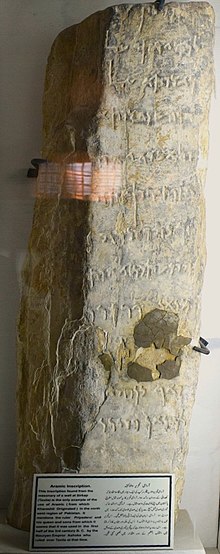| Aramaic inscription of Taxila | |
|---|---|
 Aramaic inscription of Taxila. Aramaic inscription of Taxila. | |
| Material | Portion of octagonal marble pillar. |
| Size | 200px |
| Writing | Aramaic |
| Created | circa 260 BCE |
| Period/culture | 3rd Century BCE |
| Discovered | 33.7561N 72.8292E |
| Place | Sirkap, Taxila, Pakistan |
| Present location | Taxila Museum, Pakistan |
 | |
The Aramaic inscription of Taxila is an inscription on a piece of marble, originally belonging to an octagonal column, discovered by Sir John Marshall in 1915 at Taxila, British India. The inscription is written in Aramaic, probably by the Indian emperor Ashoka around 260 BCE, and often categorized as one of the Minor Rock Edicts. Since Aramaic was the official language of the Achaemenid empire, which disappeared in 330 BCE with the conquests of Alexander the Great, it seems that this inscription was addressed directly to the populations of this ancient empire still present in northwestern India, or to border populations for which Aramaic remained the normal communication language. The inscription is known as KAI 273.
Related inscriptions
The discovery of this inscription was followed by that of several other inscriptions in Aramaic or Greek (or both), written by Asoka. The most famous are the Kandahar Bilingual Rock Inscription, written in Greek and Aramaic, or the Kandahar Greek Edict of Ashoka, also found in Kandahar. In 1932 another inscription in Aramaic was discovered in the Laghman Valley at Pul-i-Darunteh, then in 1963 an inscription in "Indo-Aramaic" alternating the Indian language and the Aramaic language, but using only the Aramaic script, the Aramaic parts translating the Indian parts transcribed in the Aramaic alphabet, also found in Kandahar. Finally, another inscription was found in Laghman, the Aramaic Inscription of Laghman.
Text of the inscription
The text of the inscription is very fragmentary, but it has been established that it contains twice, lines 9 and 12, the mention of MR'N PRYDRŠ ("our lord Priyadasi"), the characteristic title used by Ashoka.
| Object | Line | Original (Aramaic alphabet) | Transliteration | English translation |
|---|---|---|---|---|

|
1 | 𐡆𐡊𐡓𐡅𐡕𐡀 | zkrwtʾ | |
| 2 | 𐡋 𐡃𐡌𐡉𐡃𐡕𐡉 𐡏𐡋 | l dmydty ʿl | ||
| 3 | 𐡍𐡂𐡓𐡅𐡕𐡀 𐡏𐡋 | ngrwtʾ ʿl | ||
| 4 | 𐡀𐡓𐡆𐡅𐡔 𐡍𐡂𐡓𐡅𐡕𐡀 | ʾrzwš ngrwtʾ | ||
| 5 | 𐡅 𐡋𐡀𐡁𐡅𐡄𐡉 𐡄𐡅𐡅 | w lʾbwhy hww | ||
| 6 | 𐡄𐡅𐡐𐡕𐡉𐡎𐡕𐡉 𐡆𐡍𐡄 | hwptysty znh | ||
| 7 | 𐡆𐡊 𐡁𐡄𐡅𐡅𐡓𐡃𐡄 | zk bhwwrdh | ||
| 8 | 𐡄𐡅𐡍𐡔𐡕𐡅𐡍 𐡆𐡉 𐡄𐡅𐡕 | hwnštwn zy hwt | ||
| 9 | ... 𐡌𐡓𐡀𐡍 𐡐𐡓𐡉𐡃𐡓 | mrʾn Prydr... | our lord Priyadasi | |
| 10 | 𐡄 ... 𐡋𐡊𐡅𐡕𐡓 | h.... lkwtr h.... lkwtd |
||
| 11 | 𐡅𐡀𐡐 𐡁𐡍𐡅𐡄𐡉 | wʾp bnwhy | ||
| 12 | 𐡋𐡌𐡓𐡀𐡍 𐡐𐡓𐡉𐡃𐡓 | lmrʾn Prydr | our lord Priyadasi |
-
Ruins of the city of Sirkap.
-
 Another image of the inscription.
Another image of the inscription.
-
 Another image of the inscription
Another image of the inscription
See also
References
- ^ Asoka by Radhakumud Mookerji p.275
- ^ A new Aramaic inscription of Asoka found in the Laghman Valley (Afghanistan), André Dupont-Sommer Proceedings of the Academy of Inscriptions and Belles-Lettres Year 1970 114-1 p.173
- A new Aramaic inscription of Asoka discovered in Kandahar (Afghanistan), Dupont-Sommer, André, Records of the sessions of the Academy of Inscriptions and Belles-Lettres Year 1966 110-3 p.448
- Sircar, Dines Chandra, Select Inscriptions Bearing On Indian History and Civilization Vol.1 pp.78-79
- Wilson-Wright, Aren. "From Persepolis to Jerusalem: A Reevaluation of Old Persian-Hebrew Contact in the Achaemenid Period" (PDF).
nštwn……op *ništāvan
- 伊藤, 義教 (1966). "阿育王のアラム語碑について". オリエント. doi:10.5356/jorient.8.2_1.
- Altheim, Franz (2016). Geschichte Mittelasiens im Altertum. Walter de Gruyter GmbH & Co KG. pp. 339–340. ISBN 9783110865479.